Comparative Transcriptomic Profiling of Pellicle and Planktonic Cells from Carbapenem-Resistant Acinetobacter baumannii
Abstract
1. Introduction
2. Results
2.1. Differential Expression Genes Profiling
2.2. Cluster of Orthologous Groups Functional Classification of Proteins
2.3. Gene Ontology Enrichment Analysis
2.4. Kyoto Encyclopaedia Genes and Genomes Enrichment Analysis
2.4.1. Metabolism Pathways
2.4.2. Environmental Information Processing Pathways
2.4.3. Biofilm Formation Pathways
3. Discussion
4. Materials and Methods
4.1. Bacterial Strains and Culture Conditions
4.2. Pellicle and Planktonic Growth Conditions
4.3. Cell Harvesting
4.4. RNA Extraction and Quality Assessment
4.5. RNA-Sequencing Library Preparation and Illumina Sequencing
4.6. Bioinformatic Analysis of RNA-Seq Data
4.6.1. Gene Differential Expression and Enrichment Analysis for RNA-Seq Data
4.6.2. Gene Ontology and Kyoto Encyclopaedia of Genes and Genomes Pathway Enrichment Analysis
5. Conclusions
Supplementary Materials
Author Contributions
Funding
Institutional Review Board Statement
Informed Consent Statement
Data Availability Statement
Acknowledgments
Conflicts of Interest
References
- De Silva, P.M.; Kumar, A. Signal Transduction Proteins in Acinetobacter baumannii: Role in Antibiotic Resistance, Virulence, and Potential as Drug Targets. Front. Microbiol. 2019, 10, 49. [Google Scholar] [CrossRef]
- Ayobami, O.; Willrich, N.; Harder, T.; Okeke, I.N.; Eckmanns, T.; Markwart, R. The Incidence and Prevalence of Hospital-Acquired (Carbapenem-Resistant) Acinetobacter baumannii in Europe, Eastern Mediterranean and Africa: A Systematic Review and Meta-Analysis. Emerg. Microbes Infect. 2019, 8, 1747–1759. [Google Scholar] [CrossRef] [PubMed]
- Jeon, J.H.; Jang, K.M.; Lee, J.H.; Kang, L.W.; Lee, S.H. Transmission of Antibiotic Resistance Genes Through Mobile Genetic Elements in Acinetobacter baumannii and Gene-Transfer Prevention. Sci. Total Environ. 2023, 857 Pt 2, 159497. [Google Scholar] [CrossRef] [PubMed]
- Akeda, Y. Current Situation of Carbapenem-Resistant Enterobacteriaceae and Acinetobacter in Japan and Southeast Asia. Microbiol. Immunol. 2021, 65, 229–237. [Google Scholar] [CrossRef] [PubMed]
- National Institute of Health Malaysia. National Surveillance of Antibiotic Resistance Report 2021. Available online: https://www.imr.gov.my/MyOHAR/index.php/site/archive_rpt (accessed on 10 May 2023).
- World Health Organisation. WHO Publishes List of Bacteria for Which New Antibiotics Are Urgently Needed. Available online: https://www.who.int/news/item/27-02-2017-who-publishes-list-of-bacteria-for-which-new-antibiotics-are-urgently-needed (accessed on 10 May 2023).
- Choudhary, M.; Shrivastava, R.; Vashistt, J. Acinetobacter baumannii Biofilm Formation: Association with Antimicrobial Resistance and Prolonged Survival under Desiccation. Curr. Microbiol. 2022, 79, 361. [Google Scholar] [CrossRef]
- Vestby, L.K.; Grønseth, T.; Simm, R.; Nesse, L.L. Bacterial Biofilm and Its Role in the Pathogenesis of Disease. Antibiotics 2020, 9, 59. [Google Scholar] [CrossRef]
- Jones, S.U.; Chew, C.H.; Yeo, C.C.; Abdullah, F.H.; Othman, N.; Kee, B.P.; Chua, K.H.; Puah, S.M. The Phenotypes and Genotypes Associated with Biofilm Formation among Methicillin-Susceptible Staphylococcus aureus (MSSA) Isolates Collected from a Tertiary Hospital in Terengganu, Malaysia. Int. Microbiol. 2023. Advance online publication. [Google Scholar] [CrossRef]
- Nait Chabane, Y.; Marti, S.; Rihouey, C.; Alexandre, S.; Hardouin, J.; Lesouhaitier, O.; Vila, J.; Kaplan, J.B.; Jouenne, T.; Dé, E. Characterisation of Pellicles Formed by Acinetobacter baumannii at the Air-Liquid Interface. PLoS ONE 2014, 9, e111660. [Google Scholar] [CrossRef]
- Martí, S.; Rodríguez-Baño, J.; Catel-Ferreira, M.; Jouenne, T.; Vila, J.; Seifert, H.; Dé, E. Biofilm Formation at the Solid-Liquid and Air-Liquid Interfaces by Acinetobacter Species. BMC Res. Notes 2011, 4, 5. [Google Scholar] [CrossRef]
- Giles, S.K.; Stroeher, U.H.; Eijkelkamp, B.A.; Brown, M.H. Identification of Genes Essential for Pellicle Formation in Acinetobacter baumannii. BMC Microbiol. 2015, 15, 116. [Google Scholar] [CrossRef]
- McQueary, C.N.; Actis, L.A. Acinetobacter baumannii Biofilms: Variations among Strains and Correlations with Other Cell Properties. J. Microbiol. 2011, 49, 243–250. [Google Scholar] [CrossRef]
- Marti, S.; Nait Chabane, Y.; Alexandre, S.; Coquet, L.; Vila, J.; Jouenne, T.; Dé, E. Growth of Acinetobacter baumannii in Pellicle Enhanced the Expression of Potential Virulence Factors. PLoS ONE 2011, 6, e26030. [Google Scholar] [CrossRef] [PubMed]
- Kentache, T.; Ben Abdelkrim, A.; Jouenne, T.; Dé, E.; Hardouin, J. Global Dynamic Proteome Study of a Pellicle-Forming Acinetobacter baumannii Strain. Mol. Cell. Proteom. 2017, 16, 100–112. [Google Scholar] [CrossRef]
- Stark, R.; Grzelak, M.; Hadfield, J. RNA Sequencing: The Teenage Years. Nat. Rev. Genet. 2019, 20, 631–656. [Google Scholar] [CrossRef]
- De Silva, P.M.; Patidar, R.; Graham, C.I.; Brassinga, A.K.C.; Kumar, A. A Response Regulator Protein with Antar Domain, AvnR, in Acinetobacter baumannii ATCC 17978 Impacts Its Virulence and Amino Acid Metabolism. Microbiology 2020, 166, 554–566. [Google Scholar] [CrossRef] [PubMed]
- Islam, M.M.; Kim, K.; Lee, J.C.; Shin, M. LeuO, a LysR-Type Transcriptional Regulator, Is Involved in Biofilm Formation and Virulence of Acinetobacter baumannii. Front. Cell. Infect. Microbiol. 2021, 11, 738706. [Google Scholar] [CrossRef]
- Sun, X.; Ni, Z.; Tang, J.; Ding, Y.; Wang, X.; Li, F. The abaI/abaR Quorum Sensing System Effects on Pathogenicity in Acinetobacter baumannii. Front. Microbiol. 2021, 12, 679241. [Google Scholar] [CrossRef] [PubMed]
- Ng, H.K.; Puah, S.M.; Teh, C.S.J.; Idris, N.; Chua, K.H. Characterisation of pellicle-forming ability in clinical carbapenem-resistant Acinetobacter baumannii. PeerJ 2023, 11, e15304. [Google Scholar] [CrossRef] [PubMed]
- Valcek, A.; Collier, J.; Botzki, A.; Van der Henst, C. Acinetobase: The Comprehensive Database and Repository of Acinetobacter Strains. Database 2022, 2022, baac099. [Google Scholar] [CrossRef] [PubMed]
- Jacobs, A.C.; Thompson, M.G.; Black, C.C.; Kessler, J.L.; Clark, L.P.; McQueary, C.N.; Gancz, H.Y.; Corey, B.W.; Moon, J.K.; Si, Y.; et al. AB5075, a Highly Virulent Isolate of Acinetobacter baumannii, as a Model Strain for the Evaluation of Pathogenesis and Antimicrobial Treatments. mBio 2014, 5, e01076-14. [Google Scholar] [CrossRef]
- Krasauskas, R.; Skerniškytė, J.; Armalytė, J.; Sužiedėlienė, E. The Role of Acinetobacter baumannii Response Regulator BfmR in Pellicle Formation and Competitiveness via Contact-Dependent Inhibition System. BMC Microbiol. 2019, 19, 241. [Google Scholar] [CrossRef]
- Li, H.; Du, X.; Chen, C.; Qi, J.; Wang, Y. Integrating Transcriptomics and Metabolomics Analysis on Kojic Acid Combating Acinetobacter baumannii Biofilm and Its Potential Roles. Microbiol. Res. 2022, 254, 126911. [Google Scholar] [CrossRef] [PubMed]
- Zhao, T.; Zhang, Y.; Wu, H.; Wang, D.; Chen, Y.; Zhu, M.-J.; Ma, L.Z. Extracellular Aminopeptidase Modulates Biofilm Development of Pseudomonas aeruginosa by Affecting Matrix Exopolysaccharide and Bacterial Cell Death. Environ. Microbiol. Rep. 2018, 10, 583–593. [Google Scholar] [CrossRef] [PubMed]
- Esoda, C.N.; Kuehn, M.J. Pseudomonas aeruginosa Leucine Aminopeptidase Influences Early Biofilm Composition and Structure via Vesicle-Associated Antibiofilm Activity. mBio 2019, 10, e02548-19. [Google Scholar] [CrossRef] [PubMed]
- Ranjith, K.; Ramchiary, J.; Prakash, J.S.S.; Arunasri, K.; Sharma, S.; Shivaji, S. Gene Targets in Ocular Pathogenic Escherichia coli for Mitigation of Biofilm Formation to Overcome Antibiotic Resistance. Front. Microbiol. 2019, 10, 1308. [Google Scholar] [CrossRef] [PubMed]
- Jia, J.; Xue, X.; Guan, Y.; Fan, X.; Wang, Z. Biofilm Characteristics and Transcriptomic Profiling of Acinetobacter johnsonii Defines Signatures for Planktonic and Biofilm Cells. Environ. Res. 2022, 213, 113714. [Google Scholar] [CrossRef]
- Davies, D.G.; Marques, C.N.H. A Fatty Acid Messenger Is Responsible for Inducing Dispersion in Microbial Biofilms. J. Bacteriol. 2009, 191, 1393–1403. [Google Scholar] [CrossRef]
- Li, Y.; Feng, T.; Wang, Y. The Role of Bacterial Signaling Networks in Antibiotics Response and Resistance Regulation. Mar. life Sci. Technol. 2022, 4, 163–178. [Google Scholar] [CrossRef]
- Abdi, S.N.; Ghotaslou, R.; Ganbarov, K.; Mobed, A.; Tanomand, A.; Yousefi, M.; Asgharzadeh, M.; Kafil, H.S. Acinetobacter baumannii Efflux Pumps and Antibiotic Resistance. Infect. Drug Resist. 2020, 13, 423–434. [Google Scholar] [CrossRef]
- Kolodkin-Gal, I.; Romero, D.; Cao, S.; Clardy, J.; Kolter, R.; Losick, R. D-Amino Acids Trigger Biofilm Disassembly. Science 2010, 328, 627–629. [Google Scholar] [CrossRef]
- Blaschke, U.; Skiebe, E.; Wilharm, G. Novel Genes Required for Surface-Associated Motility in Acinetobacter baumannii. Curr. Microbiol. 2021, 78, 1509–1528. [Google Scholar] [CrossRef] [PubMed]
- Wang, J.; Zhou, Z.; He, F.; Ruan, Z.; Jiang, Y.; Hua, X.; Yu, Y. The Role of the Type VI Secretion System vgrG Gene in the Virulence and Antimicrobial Resistance of Acinetobacter baumannii ATCC 19606. PLoS ONE 2018, 13, e0192288. [Google Scholar] [CrossRef] [PubMed]
- Kim, J.; Lee, J.-Y.; Lee, H.; Choi, J.Y.; Kim, D.H.; Wi, Y.M.; Peck, K.R.; Ko, K.S. Microbiological Features and Clinical Impact of the Type VI Secretion System (T6SS) in Acinetobacter baumannii Isolates Causing Bacteremia. Virulence 2017, 8, 1378–1389. [Google Scholar] [CrossRef] [PubMed]
- Dong, J.-F.; Liu, C.-W.; Wang, P.; Li, L.; Zou, Q.-H. The Type VI Secretion System in Acinetobacter baumannii Clinical Isolates and Its Roles in Antimicrobial Resistance Acquisition. Microb. Pathog. 2022, 169, 105668. [Google Scholar] [CrossRef]
- Repizo, G.D.; Gagné, S.; Foucault-Grunenwald, M.-L.; Borges, V.; Charpentier, X.; Limansky, A.S.; Gomes, J.P.; Viale, A.M.; Salcedo, S.P. Differential Role of the T6SS in Acinetobacter baumannii Virulence. PLoS ONE 2015, 10, e0138265. [Google Scholar] [CrossRef]
- Weber, B.S.; Miyata, S.T.; Iwashkiw, J.A.; Mortensen, B.L.; Skaar, E.P.; Pukatzki, S.; Feldman, M.F. Genomic and Functional Analysis of the Type VI Secretion System in Acinetobacter. PLoS ONE 2013, 8, e55142. [Google Scholar] [CrossRef] [PubMed]
- Rajput, A.; Seif, Y.; Choudhary, K.S.; Dalldorf, C.; Poudel, S.; Monk, J.M.; Palsson, B.O. Pangenome Analytics Reveal Two-Component Systems as Conserved Targets in ESKAPEE Pathogens. mSystems 2021, 6, e00981-20. [Google Scholar] [CrossRef]
- He, R.; Zuo, Y.; Zhao, L.; Ma, Y.; Yan, Q.; Huang, L. Copper Stress by Nutritional Immunity Activates the CusS-CusR Two-Component System That Contributes to Vibrio alginolyticus Anti-Host Response but Affects Virulence-Related Properties. Aquaculture 2021, 532, 736012. [Google Scholar] [CrossRef]
- Williams, C.L.; Neu, H.M.; Alamneh, Y.A.; Reddinger, R.M.; Jacobs, A.C.; Singh, S.; Abu-Taleb, R.; Michel, S.L.J.; Zurawski, D.V.; Merrell, D.S. Characterization of Acinetobacter baumannii Copper Resistance Reveals a Role in Virulence. Front. Microbiol. 2020, 11, 16. [Google Scholar] [CrossRef]
- Chen, L.; Wang, Y.; Fan, L.; Yang, N.; Zeng, J.; Guo, G.; Li, Q.; Wang, P.; Zeng, W.; Zheng, J. Response Regulator KdpE Contributes to Aeromonas dhakensis Virulence. Aquaculture 2023, 568, 739298. [Google Scholar] [CrossRef]
- König, P.; Averhoff, B.; Müller, V. K(+) and Its Role in Virulence of Acinetobacter baumannii. Int. J. Med. Microbiol. 2021, 311, 151516. [Google Scholar] [CrossRef]
- Tiwari, M.; Panwar, S.; Tiwari, V. Assessment of Potassium Ion Channel during Electric Signalling in Biofilm Formation of Acinetobacter baumannii for Finding Antibiofilm Molecule. Heliyon 2023, 9, e12837. [Google Scholar] [CrossRef] [PubMed]
- Aranda, P.S.; LaJoie, D.M.; Jorcyk, C.L. Bleach Gel: A Simple Agarose Gel for Analyzing RNA Quality. Electrophoresis 2012, 33, 366–369. [Google Scholar] [CrossRef] [PubMed]
- Babicki, S.; Arndt, D.; Marcu, A.; Liang, Y.; Grant, J.R.; Maciejewski, A.; Wishart, D.S. Heatmapper: Web-Enabled Heat Mapping for All. Nucleic Acids Res. 2016, 44, W147–W153. [Google Scholar] [CrossRef] [PubMed]
- Galperin, M.Y.; Wolf, Y.I.; Makarova, K.S.; Vera Alvarez, R.; Landsman, D.; Koonin, E.V. COG Database Update: Focus on Microbial Diversity, Model Organisms, and Widespread Pathogens. Nucleic Acids Res. 2021, 49, D274–D281. [Google Scholar] [CrossRef]
- Huerta-Cepas, J.; Szklarczyk, D.; Heller, D.; Hernández-Plaza, A.; Forslund, S.K.; Cook, H.; Mende, D.R.; Letunic, I.; Rattei, T.; Jensen, L.J.; et al. EggNOG 5.0: A Hierarchical, Functionally and Phylogenetically Annotated Orthology Resource Based on 5090 Organisms and 2502 Viruses. Nucleic Acids Res. 2019, 47, D309–D314. [Google Scholar] [CrossRef]
- Moriya, Y.; Itoh, M.; Okuda, S.; Yoshizawa, A.C.; Kanehisa, M. KAAS: An Automatic Genome Annotation and Pathway Reconstruction Server. Nucleic Acids Res. 2007, 35, W182–W185. [Google Scholar] [CrossRef]
- Chen, L.; Chu, C.; Lu, J.; Kong, X.; Huang, T.; Cai, Y.-D. Gene Ontology and KEGG Pathway Enrichment Analysis of a Drug Target-Based Classification System. PLoS ONE 2015, 10, e0126492. [Google Scholar] [CrossRef]

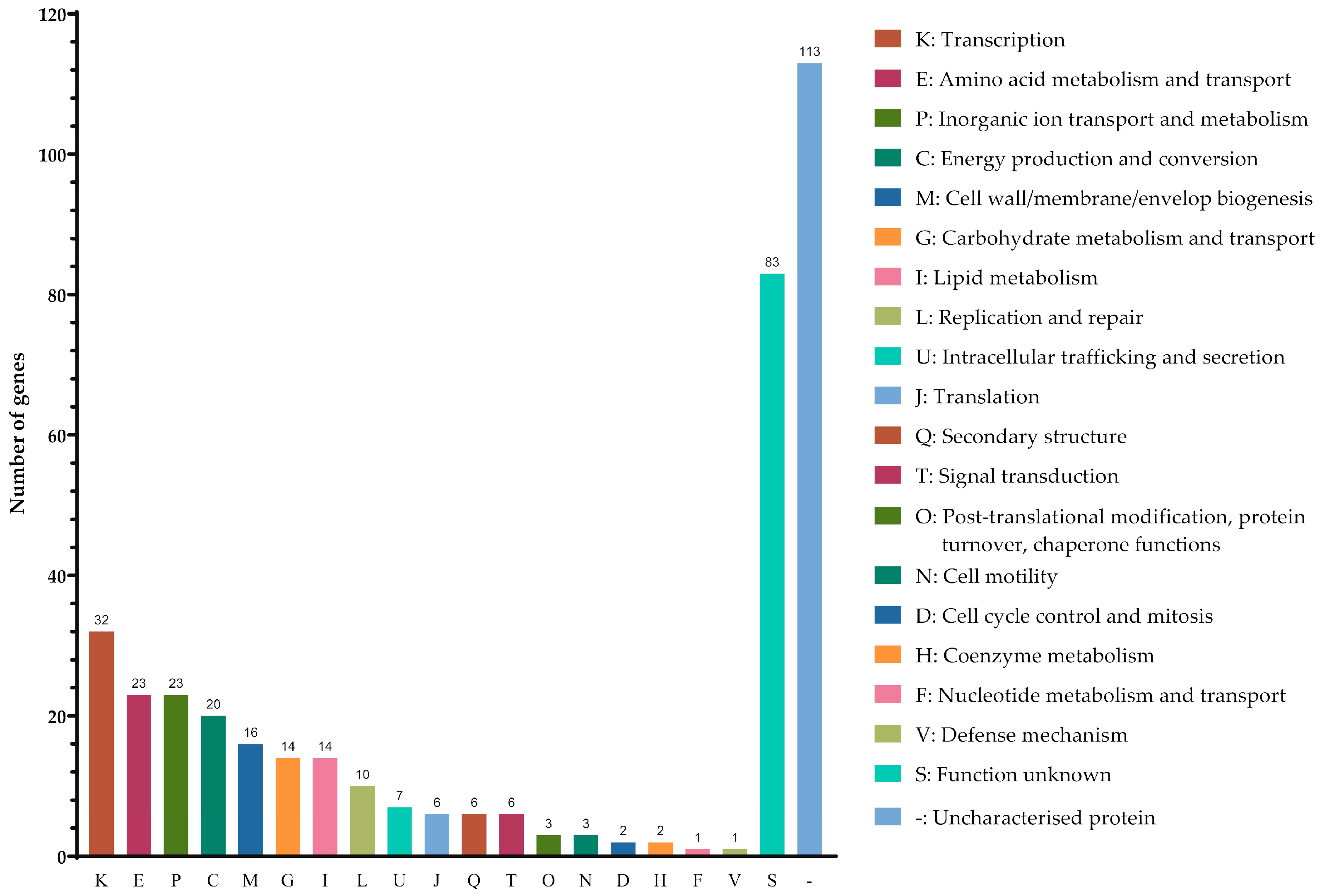

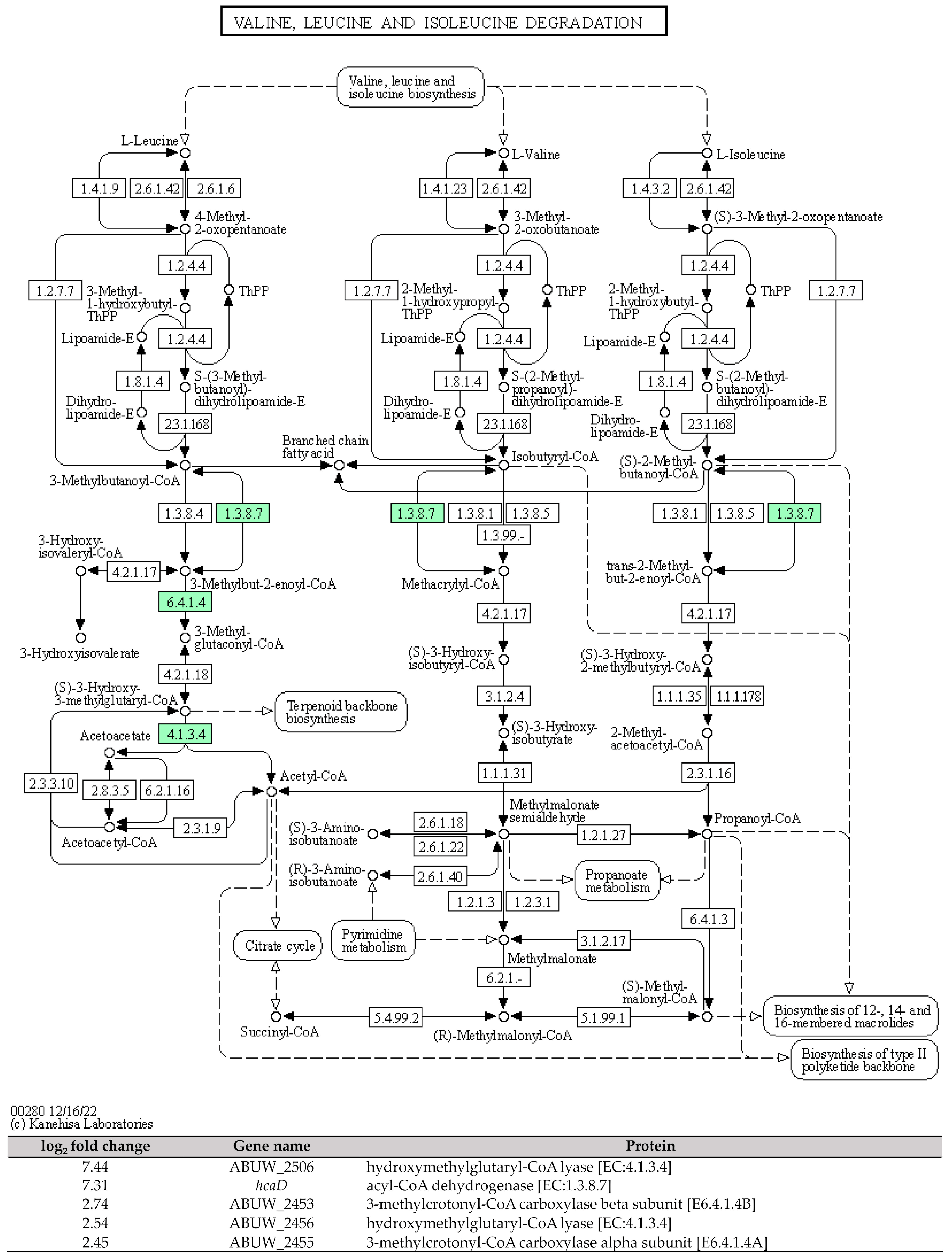
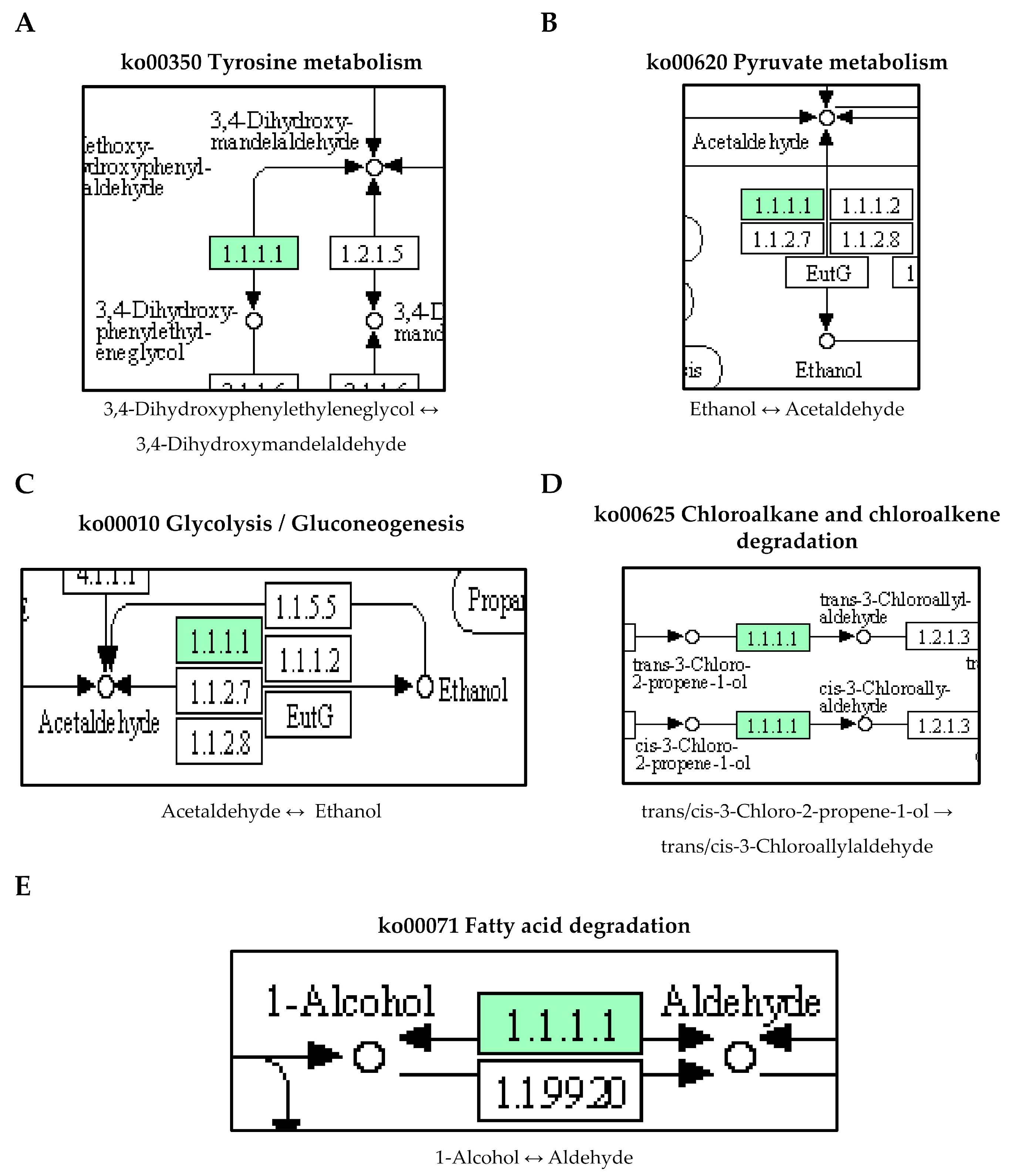

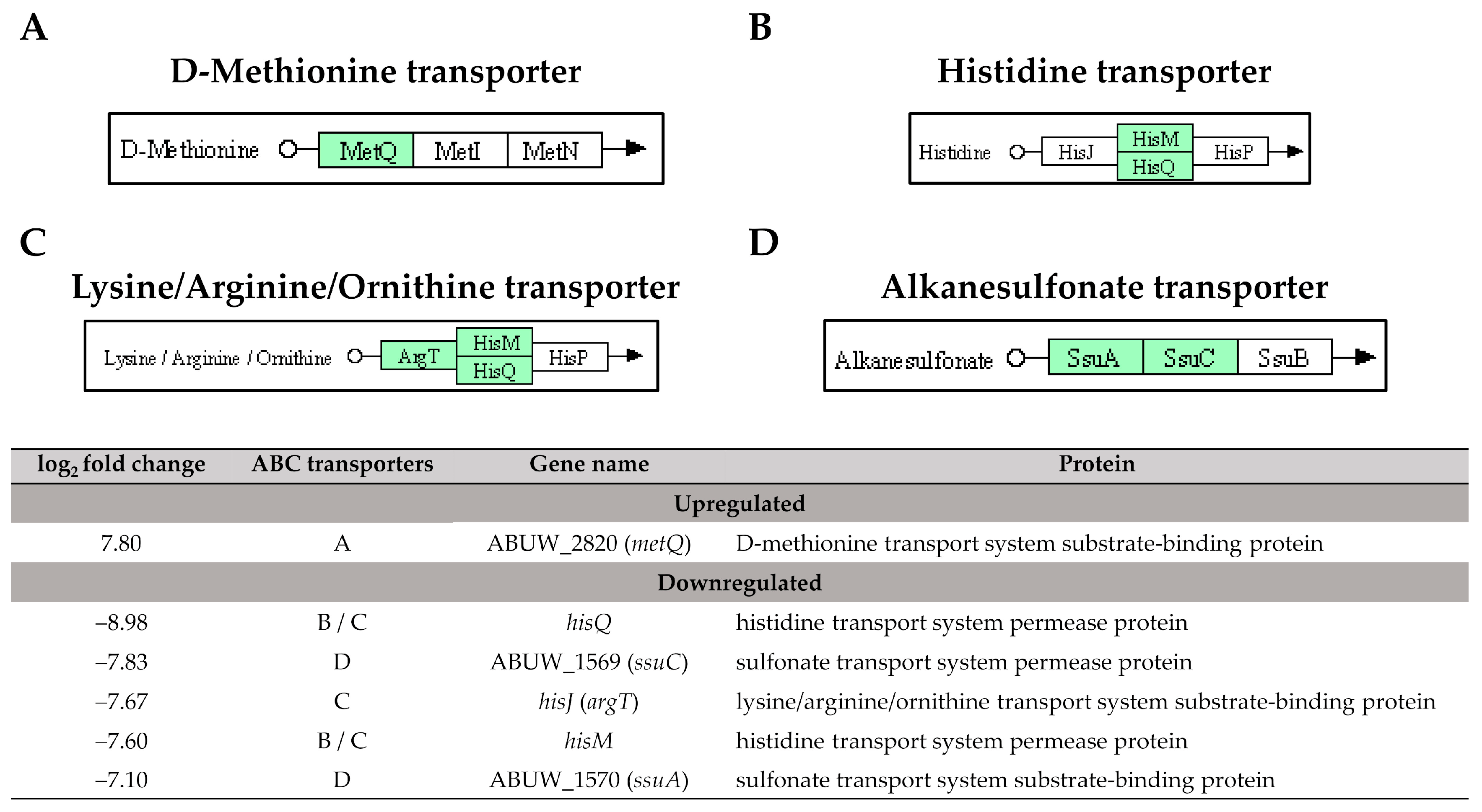
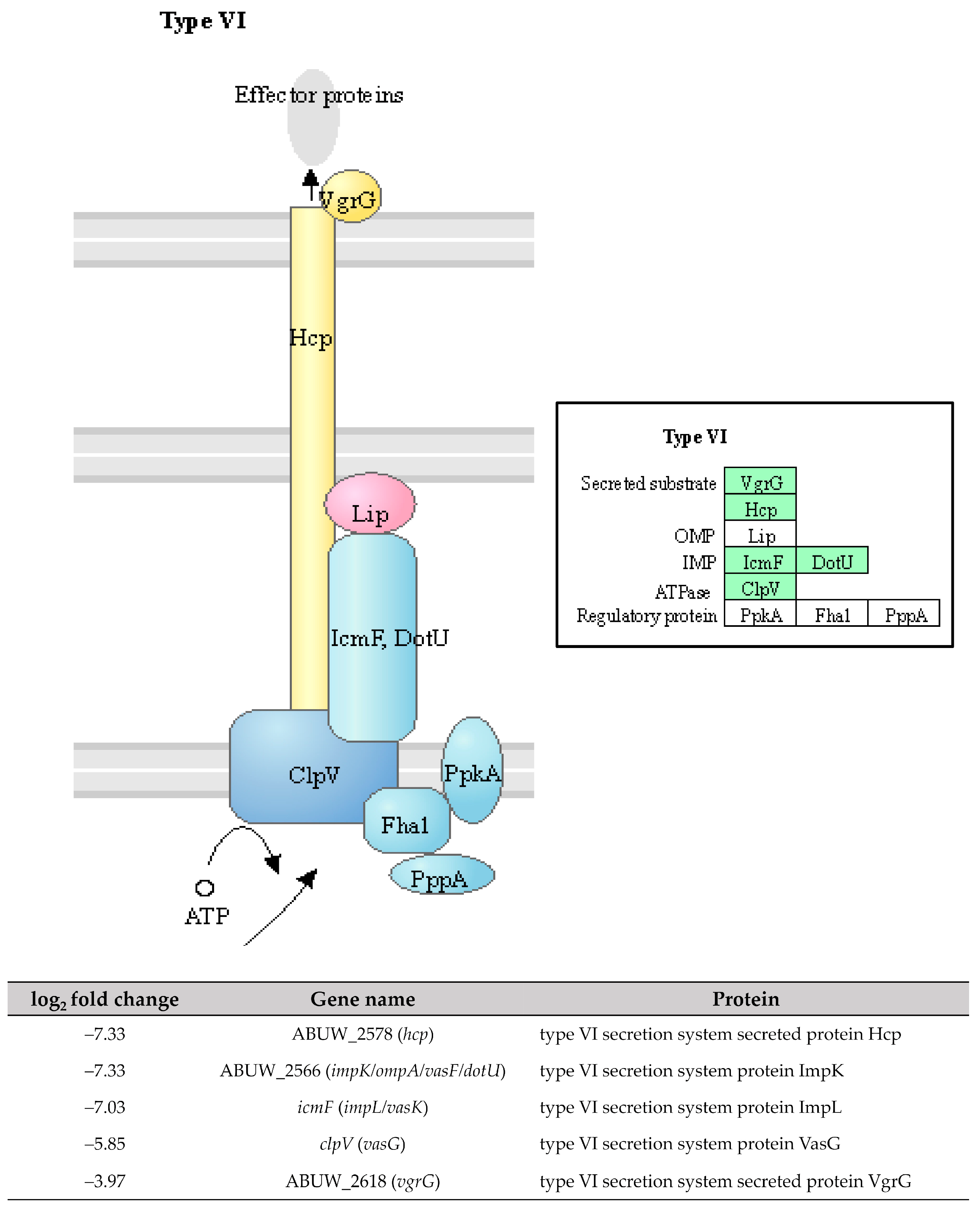

| KEGG Orthology | KEGG Pathway | Enrichment Score | P-Value | DEGs Number | Background Number | List of DEG | |
|---|---|---|---|---|---|---|---|
| Upregulated | Downregulated | ||||||
| K09100 Metabolism | |||||||
| K09105 Amino acid metabolism | ko00280 Valine, leucine, and isoleucine degradation | 1.9510 | 0.0112 | 6 | 21 | ABUW_2506, hcaD, ABUW_2453, ABUW_2456, ABUW_2455 | ABUW_1150 |
| ko00310 Lysine degradation | 1.1016 | 0.0791 | 3 | 11 | ABUW_1519 | gabD2, ABUW_1150 | |
| ko00330 Arginine and proline metabolism | 0.7820 | 0.1652 | 3 | 15 | astA2, ABUW_2807 | ABUW_1150 | |
| ko00260 Glycine, serine, and threonine metabolism | 0.2754 | 0.5303 | 3 | 29 | ydcW, ABUW_1519 | ABUW_1149 | |
| ko00350 Tyrosine metabolism | 0.4501 | 0.3547 | 2 | 13 | ABUW_1624 | gabD2 | |
| ko00380 Tryptophan metabolism | 0.4087 | 0.3902 | 2 | 14 | - | ABUW_1150, ABUW_1948 | |
| K09101 Carbohydrate metabolism | ko00053 Ascorbate and aldarate metabolism | 3.1606 | 0.0007 | 5 | 9 | gudD, ABUW_2787, kdgD, garD | ABUW_1150 |
| ko00620 Pyruvate metabolism | 0.3450 | 0.4518 | 4 | 36 | ABUW_1624, ald1, ABUW_0255 | ABUW_1150 | |
| ko00650 Butanoate metabolism | 0.7713 | 0.1693 | 4 | 23 | ABUW_0255, ABUW_2506, ABUW_2456 | gabD2 | |
| ko00010 Glycolysis / Gluconeogenesis | 0.4244 | 0.3764 | 3 | 23 | ABUW_1624, ald1 | ABUW_1150 | |
| ko00020 Citrate cycle (TCA cycle) | 0.2165 | 0.6075 | 2 | 21 | ABUW_0255 | uca | |
| K09111 Xenobiotics biodegradation and metabolism | ko00627 Aminobenzoate degradation | 2.3840 | 0.0041 | 4 | 8 | hcaB, vanA, vanB | ABUW_1978 |
| ko00625 Chloroalkane and chloroalkene degradation | 1.3229 | 0.0475 | 2 | 4 | ABUW_1624 | ABUW_1150 | |
| ko00984 Steroid degradation | 1.0218 | 0.0951 | 1 | 1 | ABUW_2770 | - | |
| K09109 Metabolism of terpenoids and polyketides | ko00981 Insect hormone biosynthesis | 1.0218 | 0.0951 | 1 | 1 | - | ABUW_1150 |
| ko00903 Limonene degradation | 1.0218 | 0.0951 | 1 | 1 | - | ABUW_1150 | |
| K09102 Energy metabolism | ko00920 Sulfur metabolism | 0.3177 | 0.4811 | 3 | 27 | msuE | ABUW_1570, ABUW_1569 |
| K09103 Lipid metabolism | ko00071 Fatty acid degradation | 1.2338 | 0.0584 | 4 | 16 | hcaD, ABUW_1624 | ABUW_1150, ABUW_1151 |
| K09104 Nucleotide metabolism | ko00230 Purine metabolism | 1.4204 | 0.0380 | 1 | 51 | - | guaD1 |
| K09106 Metabolism of other amino acids | ko00470 D-Amino acid metabolism | 0.3091 | 0.4908 | 2 | 17 | ABUW_1519, ABUW_2787 | - |
| K09108 Metabolism of cofactors and vitamins | ko00740 Riboflavin metabolism | 0.6109 | 0.2449 | 2 | 10 | msuE | ABUW_2498 |
| K09110 Biosynthesis of other secondary metabolites | ko00996 Biosynthesis of various alkaloids | 1.0218 | 0.0951 | 1 | 1 | hcaA | - |
| K09130 Environmental Information Processing | |||||||
| K09131 Membrane transport | ko02010 ABC transporters | 0.4935 | 0.3210 | 6 | 49 | ABUW_2820 | ABUW_1570, ABUW_1569, hisJ, hisM, hisQ |
| ko03070 Bacterial secretion system | 0.8226 | 0.1505 | 5 | 30 | - | ABUW_2618, ABUW_2578, icmF, ABUW_2566, clpV | |
| K09132 Signal transduction | ko02020 Two-component system | 0.3124 | 0.4871 | 5 | 60 | ABUW_1507, irlR, kdpB | pfeA, wza |
| K09140 Cellular Processes | |||||||
| K09145 Cellular community—prokaryotes | ko02025 Biofilm formation—Pseudomonas aeruginosa | 3.5291 | 0.0003 | 9 | 25 | - | ABUW_2572, icmF, ABUW_2567, ABUW_2568, ABUW_2580, ABUW_2579, ABUW_2578, ABUW_2575, clpV |
| ko02026 Biofilm formation—Escherichia coli | 0.4087 | 0.3902 | 2 | 14 | - | wza, ABUW_1145 | |
| K09150 Organismal Systems | |||||||
| K09152 Endocrine system | ko03320 PPAR signaling pathway | 1.1288 | 0.0743 | 2 | 5 | desC, hcaD | - |
| K09160 Human Diseases | |||||||
| K09167 Endocrine and metabolic disease | ko04936 Alcoholic liver disease | 2.4985 | 0.0032 | 3 | 4 | desC, hcaD | ABUW_1150 |
| K09171 Infectious disease: bacterial | ko05131 Shigellosis | 1.0218 | 0.0951 | 1 | 1 | - | ABUW_2052 |
Disclaimer/Publisher’s Note: The statements, opinions and data contained in all publications are solely those of the individual author(s) and contributor(s) and not of MDPI and/or the editor(s). MDPI and/or the editor(s) disclaim responsibility for any injury to people or property resulting from any ideas, methods, instructions or products referred to in the content. |
© 2023 by the authors. Licensee MDPI, Basel, Switzerland. This article is an open access article distributed under the terms and conditions of the Creative Commons Attribution (CC BY) license (https://creativecommons.org/licenses/by/4.0/).
Share and Cite
Ng, H.K.; Puah, S.M.; Teh, C.S.J.; Idris, N.; Chua, K.H. Comparative Transcriptomic Profiling of Pellicle and Planktonic Cells from Carbapenem-Resistant Acinetobacter baumannii. Antibiotics 2023, 12, 1185. https://doi.org/10.3390/antibiotics12071185
Ng HK, Puah SM, Teh CSJ, Idris N, Chua KH. Comparative Transcriptomic Profiling of Pellicle and Planktonic Cells from Carbapenem-Resistant Acinetobacter baumannii. Antibiotics. 2023; 12(7):1185. https://doi.org/10.3390/antibiotics12071185
Chicago/Turabian StyleNg, Heng Kang, Suat Moi Puah, Cindy Shuan Ju Teh, Nuryana Idris, and Kek Heng Chua. 2023. "Comparative Transcriptomic Profiling of Pellicle and Planktonic Cells from Carbapenem-Resistant Acinetobacter baumannii" Antibiotics 12, no. 7: 1185. https://doi.org/10.3390/antibiotics12071185
APA StyleNg, H. K., Puah, S. M., Teh, C. S. J., Idris, N., & Chua, K. H. (2023). Comparative Transcriptomic Profiling of Pellicle and Planktonic Cells from Carbapenem-Resistant Acinetobacter baumannii. Antibiotics, 12(7), 1185. https://doi.org/10.3390/antibiotics12071185






